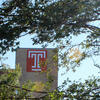
One year after an EF2-level tornado hit campus, Temple University’s Ambler Campus is finding its footing with a renewed sense of purpose and commitment to research and conservation.
Read the story by Temple University Director of Communications Stephen Orbanek with photos by University Photographer Ryan S. Brandenberg and Shorthand design by Brent Baum: https://news.temple.edu/2022-08-31/weathering-storm.
On Thursday, September 1, 2022, the Temple community gathered together to remember the day one year ago that Temple University Ambler and its surrounding communities were forever changed by a tornado spawned by Hurricane Ida.
It was a day to reflect, but also a day to look toward the future, highlighting how far we’ve come in one year and the hands-on research opportunities that have been undertaken on campus since the storm. It was also a time to express our profound appreciation for the countless people who have supported the campus in this year of challenge and change.
We’d like to thank all of our speakers who joined us in this special remembrance program including, Gregory Mandel, Provost and Laura H. Carnell Professor of Law at Temple University, Temple Senior Vice President and Chief Operating Officer Ken Kaiser, Ambler Arboretum Director Kathy Salisbury, Temple Ambler Field Station Director Amy Freestone, Kenneth E. Lawrence, Jr., Vice Chair of the Montgomery County Commissioners, Todd Stephens, Pennsylvania State Representative for the 151st District, Senator Maria Collett, Pennsylvania State Senator for District 12, Senator Vincent Hughes, Pennsylvania State Senator for District 7; Kate Wingert-Playdon, Associate Dean and Director of Architecture and Environmental Design in the Tyler School of Art and Architecture, Temple University; and Michelle Masucci, Vice President for Research at Temple University.
The remembrance event also included a long-delayed ribbon cutting for the Temple Ambler Field Station Research Array, which was originally scheduled for September 1, 2021. The Research Array will be home to dedicated research such as the Field Station’s ongoing study of Spotted Lantern Flies, faculty research into solar energy, and more.
Following the ribbon cutting, State Senators Collett and Hughes additionally announced a new initiative to help residents impacted by Hurricane Ida.
During our Hurricane Ida remembrance programs on September 1, visitors were invited to experience the healing power of nature — even as nature is continuing to heal — by joining Ambler Arboretum Director Kathleen Salisbury and certified Nature and Forest Therapy Guide Ryan Benz for a guided Nature & Forest Therapy Experience.
Benz guided the community on a Nature & Forest Therapy Experience, also known as Forest Bathing, or shinrin-yoku in Japan, a research-based mindfulness practice of spending time in nature for the purpose of enhancing health, wellness, and happiness.
The walk was followed by an inspirational talk given by Benz, where he shared his experience of thru-hiking the entire Appalachian Trail from Georgia to Maine.
September 1, 2022, marks one year since a tornado forever changed Temple University Ambler and our surrounding communities. We want our neighbors to know that we are here for them just as they have been here for us. The outpouring of support for the campus has been overwhelming as we continue to recover, reimagine and rebuild.
In these images you will clearly see how our campus has changed and how it is healing and building back better as we explore Temple Ambler before the storm, after the storm and today.
From "Truffula Trees" to Carbon Storage, Temple's Ambler Campus Offers New Discoveries One Year After Ida

Sue Snyder, staff writer for the Philadelphia Inquirer, recently visited Temple University Ambler to learn about the recovery that has taken place and the opportunities that have arisen since the remnants of Hurricane Ida spawned an EF2-level tornado that damaged the campus and our surrounding communities. The story may be found here: https://bit.ly/3RBk1Lm (may require an Inquirer subscription to view).
An Arboretum of Champions
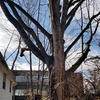
The Olympics recently had their closing ceremonies, marking the end of the competitions and the awarding of medals to champions.
Did you know there are champion trees? You can find state champions at pabigtrees.com. The Ambler Arboretum was home to five state champion trees prior to the Tornado on September 1. On September 2, we were down to one.
Our Turkish Filbert (Corylus collurna) is a champion and has also survived Hurricane Sandy, which took out an equally large tree of the same species nearby.
But just as the Olympics crowned new champions, the Ambler Arboretum is happy to report, so have we!
Volunteers from the PA Big trees program came out to remeasure the existing champion as it has lost some height and width in the storm. While they were here, they measured a few of the remaining trees on campus. We are thrilled to report that the Ambler Arboretum is the proud home of the 4th largest Honey Locust (Gleditsia triacanthos) recorded in the state, the third largest Southern Red Oak (Quercus falcata) and the state's largest Turkish Filbert.
We plan to celebrate Arbor Day, Friday, April 29, with a Tree Hugging event — wrapping our arms around trees on campus to get measurements to see if we have any other champions among us. Keep an eye out for the details!
Supporting Recovery in the Ambler Arboretum
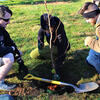
The energy and creativity of volunteers provide essential support to the Ambler Arboretum gardens and programs.
Drop in on Tuesdays, 1:00 - 3:00pm
The Arboretum welcomes volunteers with an interest in plants to help Horticulture Staff maintain the Arboretum’s gardens. Learn more about volunteering.
We are often asked how you can help with the ongoing recovery efforts. The Ambler Arboretum has a dedicated webpage on how to do just that.
From supporting the Arboretum's gift fund and the Arboretum's Endowment Fund to exploring our plant wish lists to help replace what has been lost, every donation and supportive effort helps the Arboretum come back stronger.
To the many of you that have selflessly provided support since the tornado in so many ways, thank you!
Temple Ambler Library: A Future of Innovation

The beginning of the new Innovation Studio in the Ambler Research and Collaboration Building.
The Temple University Ambler Library Building didn't escape the wrath of the EF2 tornado that ravaged campus on September 1, 2021. Ferocious winds and debris tore holes in the building's roof and blew out most of the large windows, threatening the collection of 130,000 books, periodicals, research material and historical archives inside.
As rapid-paced recovery on campus has continued, the Ambler Campus Library has worked diligently to preserve the collection. The Library has also found a new temporary home in the Ambler Learning Center.
The damaged Library Building — a staple of the Ambler Campus for decades — has been restored. The intention — to create a space for collaborative, hands-on research and study. Read more.
Temple Ambler Field Station: Finding Opportunity in Recovery

On September 1, the Temple Ambler Field Station was confronted with a seemingly impossible question.
How do you continue in-depth research in an ecosystem that has been forever changed by a natural disaster?
The answer: "Tell the story that nature has given us to tell," said Dr. Amy Freestone, Director of the Temple Ambler Field Station.
"Most of our trees were downed or stripped of branches and foliage — these were trees that were 150 years old and more, 100 feet tall and more than 1.3 meters in diameter. It was quite devastating. The change to the ecosystem was dramatic; I don't think that can be overstated," said Freestone. "While there was the immediate aftermath and shock at what had happened, we had to begin to wrap our minds around what comes next. Soon after that we began to view it as an opportunity to understand the disturbance effects on forest dynamics." Read more.
Temple Ambler Field Station Invites Students to Explore Disturbance Ecology in Aftermath of Tornado
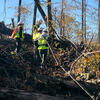
Nature is dynamic.
Ecosystems across the globe are defined by their disturbance regimes — disturbances that can be caused by storms, floods, fire and species interactions. On September 1, an EF2 tornado spawned by Hurricane Ida proved to be a massive and devastating disturbance to Temple University Ambler.
"Disturbances can reset an entire ecosystem. Understanding resilience to disturbance is a cornerstone of contemporary ecology," said Dr. Amy Freestone, Director of the Temple Ambler Field Station. "As climate change alters the frequency and severity of storms and other natural events, disturbance regimes are changing. Understanding these dynamics can help predict and mitigate future impacts."
The aftermath of the tornado has also opened up a variety of research and educational opportunities, including new undergraduate and graduate Disturbance Ecology courses — Biology 3380 and Biology 5466 — that will be offered for the first time at Temple Ambler during the second half of the spring 2022 semester. Read more.
Temple University Ambler: Before and After the Tornado
On September 1, the unthinkable happened.
The remnants of Hurricane Ida spawned a tornado that ripped through the middle of the Temple Ambler Campus and our surrounding community. The damage to campus buildings and our Arboretum gardens has been severe. Many buildings suffered roof and water damage and a considerable number of trees have been lost. Recovery efforts have continued steadily.
"The fact that both a hurricane and a tornado hit this region of the U.S. is uncommon, and that's something we need to monitor and understand. There is so much that we can now learn about climate change and other things from this," said Amy Freestone, Director of the Temple Ambler Field Station. "We are now a disturbance lab, and we have some really interesting research questions ahead of us. These are not the questions that we expected to study, but we're biologists, and we follow nature. This is where nature has decided to take us."
We are extremely grateful that none of our students, faculty or staff were injured, and we mourn the loss of members of our local communities. Please know that we are here for you as we all continue to recover and rebuild.
Together we are #ReadytoRebuild and #ComeBackStronger!
Temple Ambler: The Road to Recovery Begins
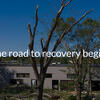
It's the late afternoon of Wednesday, Sept. 1, and Benjamin Snyder, manager of the Tyler School of Art and Architecture's Greenhouse Education and Research Complex at Temple University's Ambler Campus, is about to head home for the evening. The skies have started to open up, and the wind has picked up, too. Despite it just being 5:30 p.m., the entire area has been blanketed with an eerie darkness, akin to a scene from the middle of the night, rather than the late afternoon.
"You could tell that something was different and that this was not just a normal windstorm," Snyder said.
Snyder was in his car at 5:42 p.m., when his suspicions were confirmed. It was then that the remnants of Hurricane Ida, an EF2-level tornado, barreled through the center of the Ambler Campus. Winds reached as high as 130 mph. Hundreds of trees were either uprooted or destroyed entirely. Windows in many of the campus' buildings were blown out. Almost every building sustained some level of roof damage, including West Hall, which had the entire roof of its east and west wings removed.
As he was on his way home, Snyder decided to call an audible. Rather than ensuring his own safety, he turned around and headed back to campus.
"When you're a manager of a greenhouse and you maintain 1,600 tropical plants and then a tornado hits, your first thought is to make sure that they're all OK," Snyder said. "My response was, 'OK, this is what happened. What do we do next?'"
Read more from this story by Steve Orbanek about the tornado and the recovery at Temple Ambler.
Not Focused on What Was Lost, But What Can be Gained
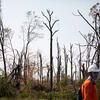
For decades, the campus has doubled as an outdoor learning laboratory. Thousands of plants and trees, some more than 100 years old, were twisted at the base, felled, or so heavily damaged they had to be taken down. Two parallel rows of pecan and walnut trees were flattened. Shaded canopies were blown away, shade gardens turned to sun gardens, roofs ripped off or damaged on 17 of 19 campus buildings, and 50 light poles lost.
At Temple Ambler — founded in 1911 as the Pennsylvania School of Horticulture for Women and one of the first of its kind in the United States, teaching women to garden and farm — what survived is perhaps just as remarkable.
The campus’ state-champion Turkish filbert tree, which also made it through Hurricane Sandy, was virtually untouched. A prodigious weeping beech that creates a shaded tunnel over a walkway was relatively unscathed, though a tree just behind it had fallen on a building. The greenhouse lost some glass panes, but all 1,600 plant species were undisturbed and three beehives left intact.
Read more in this extensive article by Sue Snyder in the Philadelphia Inquirer.
Temple’s Ambler Campus: Rebuilding
Temple Ambler wasn’t on its own after the disaster. Dr. Vicki McGarvey, Vice Provost for University College and Director of Temple University Ambler, said the next morning after the storm there were hundreds of people on campus.
“The support we’ve gotten from the main campus has just been incredible, as well as our own alumni and our friends and neighbors, we’ve just had a tremendous outpouring of support and volunteers to come and help us clean up,” she said.
This disaster is devastating, but Temple Ambler wants to turn this situation into an opportunity to expand its environmental education and climate change studies. Read more from this report by Kathryn Oleary for Temple Update.
A Symbol of Hope
Hope can come from the most unexpected places. Sometimes it’s just a kind word or deed. Sometimes it’s an offer of support. And sometimes it’s a little bit of normalcy at an exceedingly challenging time.
At Temple Ambler, hope came in the form of a little girl and her pitcher. The statute has been an iconic symbol of the campus and the Ambler Arboretum for decades. When power was restored to campus, there she was. Amid the buzz of an army of people working to restore the campus after the September 1, 2021, tornado, surrounded by downed trees, came the calming sound of water trickling from her pitcher into the pool below. Hope.
In this video, Kathy Salisbury, Director of the Ambler Arboretum at Temple University, talks about the recovery efforts taking place on campus just days after the tornado hit and the importance of this little girl and her pitcher to the history of Temple Ambler.
Supporting Ambler Campus and Ambler Arboretum Recovery Efforts
So many of you have expressed interest in supporting Temple Ambler in so many ways.
Temple University has established a Relief Fund supporting the Ambler Campus, Ambler Arboretum and the Temple Ambler Field Station recovery efforts.
With a gift today, you can help Temple Ambler rebuild and recover. Learn more about the fund at http://www.giving.temple.edu/AmblerAid.
Volunteering in the Ambler Arboretum
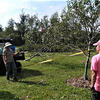
Many people have also expressed how they would like to help the Ambler Arboretum and Ambler Campus with recovery efforts directly on campus.
If you are interested in becoming an Ambler Arboretum volunteer, please fill out the online volunteer form. You may also contact [click-for-email] with questions about helping in the Ambler Arboretum.
Healing the Land, the Body, the Heart and the Spirit
As tornado recovery and rebuilding continues, the Ambler Arboretum welcomed the Lenape Nation of Pennsylvania to campus for a special healing ceremony for the land and all of us who share a special connection to it. Chief of Ceremonies Chuck GentleMoon Demund, Storykeeper Adam Waterbear DePaul, and tribal drum the Itchy Dog Singers, helped to heal hearts and mind through drumming and storytelling. Read a story by Haajrah Gilani for the Temple News about the ceremony and the group tree planting that followed.
Everyone is invited to join the Friendship Circle!
Ambler Arboretum Explores What's "On the Horizon"
The Ambler Arboretum is looking toward the future as recovery continues each day since the September 1 tornado. Some of our garden spaces were untouched while others have been changed forever.
On Sunday, October 24, Kathy Salisbury, Director of the Ambler Arboretum, provided an in-depth tour for dozens of alumni, students, community residents and friends of the Arboretum and campus, sharing stories about progress since the tornado and visions of what is on the horizon as Arboretum staff craft ideas for planting for future generations to enjoy.
As with everything, together we will #ComeBackStronger!

